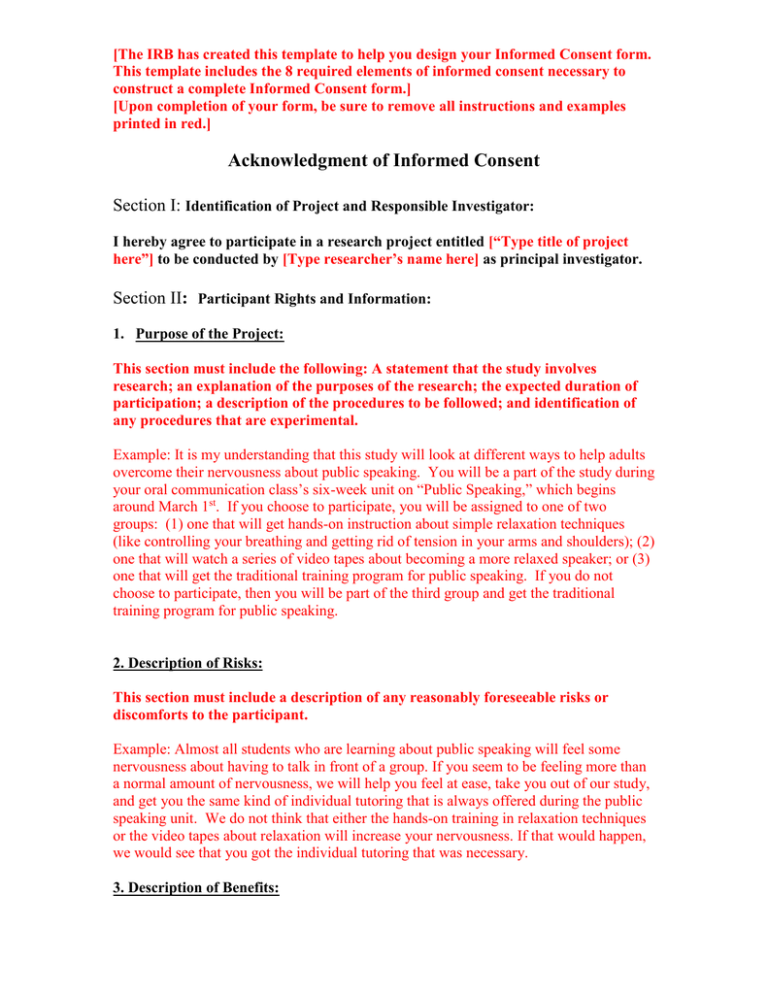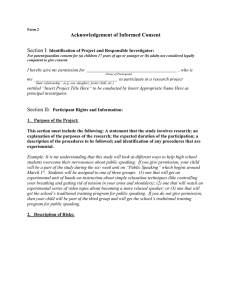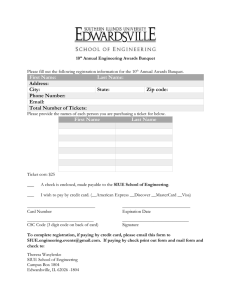Informed Consent Template for Subjects Over 18 Years of Age
advertisement

[The IRB has created this template to help you design your Informed Consent form. This template includes the 8 required elements of informed consent necessary to construct a complete Informed Consent form.] [Upon completion of your form, be sure to remove all instructions and examples printed in red.] Acknowledgment of Informed Consent Section I: Identification of Project and Responsible Investigator: I hereby agree to participate in a research project entitled [“Type title of project here”] to be conducted by [Type researcher’s name here] as principal investigator. Section II: Participant Rights and Information: 1. Purpose of the Project: This section must include the following: A statement that the study involves research; an explanation of the purposes of the research; the expected duration of participation; a description of the procedures to be followed; and identification of any procedures that are experimental. Example: It is my understanding that this study will look at different ways to help adults overcome their nervousness about public speaking. You will be a part of the study during your oral communication class’s six-week unit on “Public Speaking,” which begins around March 1st. If you choose to participate, you will be assigned to one of two groups: (1) one that will get hands-on instruction about simple relaxation techniques (like controlling your breathing and getting rid of tension in your arms and shoulders); (2) one that will watch a series of video tapes about becoming a more relaxed speaker; or (3) one that will get the traditional training program for public speaking. If you do not choose to participate, then you will be part of the third group and get the traditional training program for public speaking. 2. Description of Risks: This section must include a description of any reasonably foreseeable risks or discomforts to the participant. Example: Almost all students who are learning about public speaking will feel some nervousness about having to talk in front of a group. If you seem to be feeling more than a normal amount of nervousness, we will help you feel at ease, take you out of our study, and get you the same kind of individual tutoring that is always offered during the public speaking unit. We do not think that either the hands-on training in relaxation techniques or the video tapes about relaxation will increase your nervousness. If that would happen, we would see that you got the individual tutoring that was necessary. 3. Description of Benefits: This section must include a description of any benefits to the participant or to others that may reasonably be expected from the research. Example: We expect that college instructors will be able to use our research to make more effective decisions about how to help students overcome their nervousness when they give speeches. 4. Disclosure of Alternative Procedures: This section must include a disclosure of appropriate alternative procedures or courses of treatment, if any, that might be advantageous to the participant. Example: If you choose to not participate in the research project, the researcher will provide an alternate course of treatment or procedure for you to participate in which may be similar to the research activity or may simply be the option of non-participation. If there is no alternative procedure, simply state that there are no alternative procedures for this research except for non-participation. 5. Confidentiality of Records: This section must include a statement describing the extent, if any, to which confidentiality of records identifying the participant will be maintained. Example: We will keep a record of your scores and grades during your public speaking course at SIUE. The record will include your age, year in school, major, sex, and race. However, the record will NOT include your name, address, social security number, school ID number or any other personal information. While we are working in your class, the record will be open to your public speaking instructor. After our work with your class is done, the confidential records will be kept in a file cabinet and on computer files at our SIUE offices. They will be open only to members of our research team. 6. Available Assistance: For research involving more than minimal risk, this section must include an explanation as to whether any compensation will be offered and an explanation as to whether any medical treatments are available if injury occurs and, if so, what they consist of, or where further information may be obtained. Example: There is a very small chance that you might be one of those few students who discovers that he or she is unusually nervous about public speaking. If you have any strong, negative emotional and/or physical reactions to the work we ask you to do, then we will: (a) take immediate steps to help you feel more at ease; (b) help you make contact with the SIUE Counseling Services Office (this is only applicable when participants are SIUE students) to discuss the situation; and (c) follow through to make sure you have received any help that you feel is needed. 7. Contact Information: This section must provide an explanation of whom to contact for answers to pertinent questions about the research and research participants' rights, and whom to contact in the event of a research-related injury to the participant. If you are a student, you must include the name, office phone and email address for you faculty advisor. Example: If you have any questions about our research project or about your rights and activities as a participant, then please contact the project’s principal investigator, Dr. Elwood P. Suggins. You can call Dr. Suggins at (618) 650-1111, e-mail him at epsuggi@siue.edu, or write him at Campus Box 2999, SIUE, Edwardsville, IL 620262999. If you are a participant and become worried about your emotional and physical responses to the project’s activities, then we encourage you to immediately notify your instructor and Dr. Suggins. They will work with you to help identify the problem and solve it. You can also seek assistance from SIUE Counseling Services (at 618-650-2197 If you have any questions about your rights or any other concerns, you may also contact Linda Skelton with the SIUE Institutional Review Board at (618) 650-2958 or lskelto@siue.edu. 8. Statement of Voluntary Participation: This section must provide a statement that participation is voluntary, refusal to participate will involve no penalty or loss of benefits to which the participant is otherwise entitled, and the participant may discontinue participation at any time without penalty or loss of benefits to which the participant is otherwise entitled. Example: If you choose to join our research project, your participation will be voluntary. You can ask to withdraw from the research project at any time. If you have been in either the “hands-on” or “video” group, you will be reassigned to the “traditional” group and we will keep no records of your participation. If you have been in the “traditional” group, then we will simply stop keeping records of your participation. The changes will be made in a way that does not draw any special attention to you. We expect that there will some natural movement between groups, anyway, because of absences and other activities in which you and your classmates will be involved. All three of the groups will be covering the same information and public speaking skills at the same time, so you will not fall behind or be penalized in any way if you decide to withdraw from the project. Section III: Signatures 1. Participant: _______________________________________ Date: _______________ 2. Principal Investigator: _______________________________ Date: _______________ 3. Principal Investigator’s address:____________________________________________ ________________________________________________________________________ 4. Principal Investigator’s phone number ______________________________________ 5. E-Mail: _______________________________________________________________ Updated 05/02/12 PGC
![Lesson Study Project Informed Consent for Students 2011-12 [TEMPLATE]](http://s2.studylib.net/store/data/011897429_1-e9cd20ac12fa907a0c9dbbb5866bfc98-300x300.png)

![TEMPLATE CONSENT FORM Good morning/afternoon, my name is [INTERVIEWER’S NAME].](http://s2.studylib.net/store/data/015454953_1-11241969f9c91b19903267ef7d53bcc0-300x300.png)

